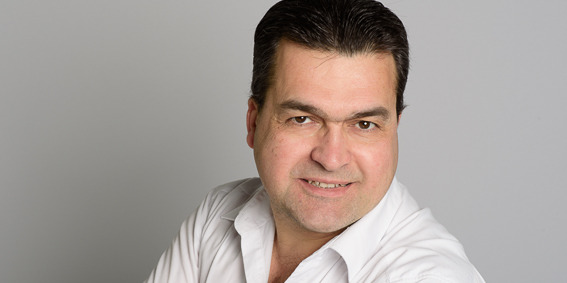In focus - George Palasantzas

What started more than 70 years ago as a theoretical scientific discovery, has now become the sole focus of dozens of research groups across the globe. The Casimir force, named after the Dutch physicist who correctly predicted it in 1948, was first measured more than 20 years ago; and yet, it still holds a number of secrets, intriguing scientists all over the world.
“I was the chair of the Casimir network in Europe, which includes more than 60 groups,” said George Palasantzas, full professor in physics at the University of Groningen. “I also receive papers from people that I know from outside Europe.
“I'd say there are now about 100 groups working on different aspects of Casimir forces. They all focus on different things, from surface-molecule, molecule-molecule, or surface-surface interactions. We're focusing on the latter. The adjacent topics include geometry, optical properties, interaction between graphene layers, cosmology, gravitation, etc.”
Born and raised in Greece, Palasantzas received a PhD from Northeastern University in Boston, Massachusetts, and moved to the Netherlands to continue his research in 1996. Together with his group at the Zernike Institute for Advanced Materials, he's been busy studying the Casimir effect and uncovering its possible applications.
Building blocks
The Casimir force only manifests on the nanometer scale, which is why it took almost 50 years for scientists to actually measure it accurately. It's defined as the attractive force between two objects in a vacuum put at up to 10 nanometres apart.
The simple explanation of the nature of the force lies in the fluctuating electromagnetic fields made of virtual particles. The short distance between the objects restricts the wavelengths that can appear there, which means that the fluctuations in the surrounding space will always be stronger. The effect is that the objects are pushed together.
“The building blocks of our universe are not electrons or quarks,” Palasantzas said. “We're also used to labelling these building blocks as cubes, or bricks, but they are not any of these things. The building blocks are fluctuating fields, which can be confined between boundaries to generate these Casimir-like forces. If your building block is a fluctuating field, imagine these continuous substances… It's hard to grasp.”
Research focus
The Casimir force is extremely important for quantum physics, and Palasantzas' group is working on and experimenting with different aspects of it. One of the important topics here is changing the sign of the force, transforming it from attractive to repulsive.
Some 12 years ago, the repulsive Casimir force was still a theoretical prediction, but since then it has been experimentally proven to be achievable. Palasantzas' group keeps iterating with different materials of the plates and the matter between them.
“I have been doing a lot of work with nanoparticles and the Casimir effect,” Palasantzas said. “I've tried to relate, especially in the Casimir effect, my previous knowledge about surface roughness, how the morphologies are affecting the Casimir force.
“For example, you have a flat surface and a rough surface. How would this affect surface forces or even functional properties of interacting systems? So, our focus is the morphology of nano-structures and surface interactions.”
Another focus point of the group is the wetting phenomenon: simply speaking, the researchers are looking for the effect that different surface morphology may have on the spreading of liquids on it. Unlike the Casimir force, the topic of wetting has been around for more than 200 years — and yet there's still much more to be uncovered.
A better understanding of wetting is important for the areas like self-cleaning, anti-icing, adhesion and friction of material surfaces, fluid flows, printing, etc. In addition to that, a lot of attention has been paid in recent years to the possibility of creating superhydrophobic surfaces, that is, ones that are extremely difficult to wet. In nature, a good example of such a surface is the lotus leaf.
The practical applications of superhydrophobic surfaces Palasantzas' group is working on include things as simple as car windshields or water trapping. The applicability in this industry is harder to achieve, though, as it obviously requires a transparent material. On a larger scale, hydrophobicity is important for self-cleaning surfaces, including special paper, which has antimicrobial properties and fits perfectly for surgical operations.
Applying force
As for the Casimir effect, the seemingly weak force can also have extremely strong consequences in the real world — but not before the researchers have found ways to control and adjust it.
One of the most widely publicised real-life applications of this fundamental research lies in its potential use in switches in nanoelectromechanical and microelectromechanical systems (NEMS/MEMS). One of the possibilities, which Palasantzas worked on as part of a research group 10 years ago, is to make a switch of the AIST, an alloy of silver, indium, antimony and tellurium. The AIST switches between crystalline and amorphous states, which changes the magnitude of the Casimir force.
“The state remains stable even when the power is turned off, which is a unique feature,” Palasantzas said in an interview for the New Scientist about the invention.
The repulsive Casimir force also has enormous potential for real-life applications. It could induce what's called “Casimir levitation” to be used in nano- and micro-bearings, making them effectively friction-free. In addition to that, the repulsive Casimir force could be the solution to a stiction issue in microengineering, which the attractive force has created.
For for more information please contact Prof. George Palasatzas
More news
-
15 September 2025
Successful visit to the UG by Rector of Institut Teknologi Bandung
